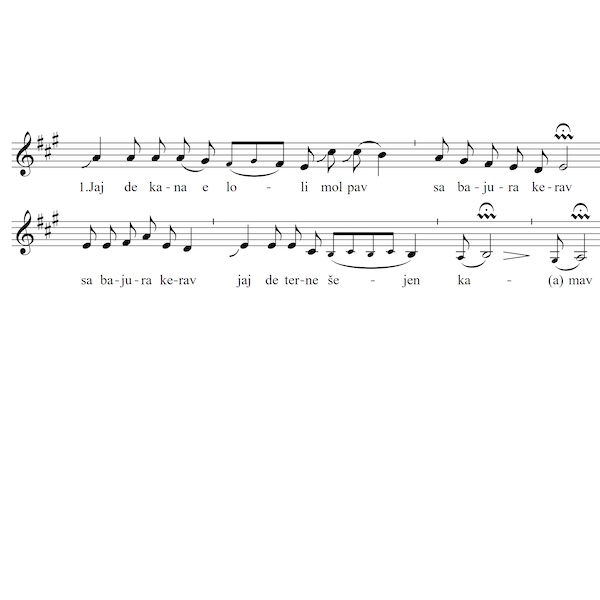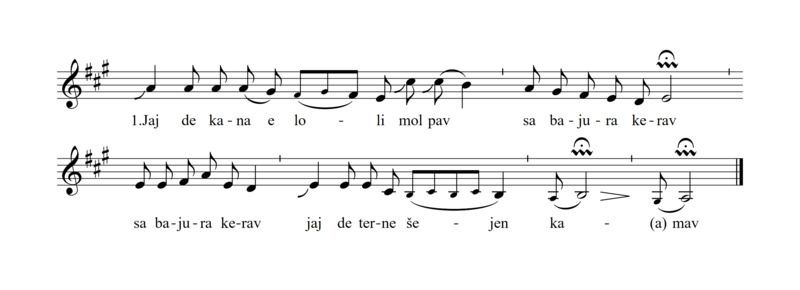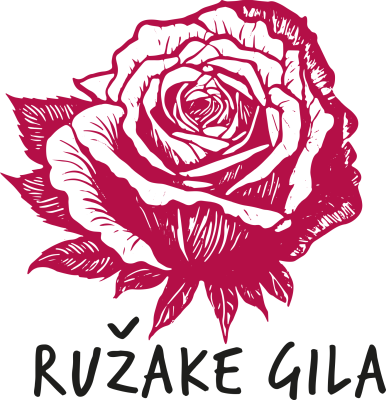
Kana e loli mol pav
- Genre
- langsames Lied
- Thema
- Gefängnislied
- DOI
- doi.org/10.21939/r0mh-kv58
Content
Recordings
Kana e loli mol pav is a very old song. Ruža Nikolić-Lakatos uses the old lyrics but changes the name of the bridge that appears in the song. As she lived in Vienna, she sang about the Viennese bridge, bečesko podo. The song is about the relationship between a man and a woman and about jealousy.
Musical transcription based on the booklet accompanying the CD Amare gila - Unsere Lieder / Our Songs
In Kana e loli mol pav is told from the perspective of an imprisoned Roma boy. He complains that his wife is cheating on him while he is serving his sentence. That's why he wants the bridge, over which his wife always goes to the drunken gaže (non-Roma), to collapse. Instead of bečesko podo (Viennese bridge), any other bridge can be used. Ruža Nikolić-Lakatos always sang about the 'Viennese bridge' because she lived in Vienna. In 1976, the Vienna Reichsbrücke collapsed, since then, the Roma have jokingly said that Ruža caused it to collapse with her song.
Kana e loli mol pav was the song that motivated ethnomusicologist Ursula Hemetek to research the songs of Ruža Nikolić-Lakatos. When she heard the singer sing the song in the documentary Ihr werdet uns nie verstehen / You Will Never Understand Us (1988), she was initially fascinated but didn’t understand anything. It was only through her subsequent research that she began to approach understanding:

“I learned that behind such a [song] text there can be a philosophy of life, the history of a people, a whole universe. I began to understand why the song stuck with me the first time I heard it in the movie. There is a great expressiveness to this style and sometimes content is conveyed through melody and singing style without a required understanding of the lyrics; I have experienced this more than once. But it is mainly due to Ruža's individual way of singing.”
Source:
- Hemetek, Ursula. “Music of the Roma and Applied Ethnomusicology: Stages of an Approach.” In: Roma and Travellers. Identities in Transition, edited by Thurner, Erika, Hussl, Elisabeth and Eder-Joardan, Beate. Innsbruck: University Press, 2015. pp. 173-190.
Ruža Nikolić-Lakatos and The Gypsy Family published this version of Kana e loli mol pav on their CD Ruzsa Shej.
Commentary
(GERMAN ONLY) Ruža Nikolić-Lakatos and Mišo Nikolić explain the lyrics to Kana e loli mol pav to the ethnomusicologist Ursula Hemetek and comment on the transmission process. The recording was made during a visit to the Nikolić family home in 1992.
Lyrics
Stanza 1
| Jaj de kana i loli mol pav, | When I drink red wine, |
| sa bajura kerav, | I do stupid things, |
| sa bajura kerav, | I do stupid things |
| jaj de terne šejan kamav. | and love young girls. |
Stanza 2
| Jaj de kana e parni mol pav, | When I drink white wine, |
| pale bajo kerav, | again I start a fight, |
| pale bajo kerav | I start a fight |
| jaj de šingalen malavav. | and scuffle with policemen. |
Stanza 3
| Apal phendas: | Again he said: |
| Ande pelem, mamo, | I have come, mother, |
| ando vesedelmo, | to prison, |
| ando vesedelmo | to prison |
| jaj de maškar le falura. | between high walls. |
Stanza 4
| Jaj de le ma avri, šeje, | Get me out, girl, |
| po Del me mangav tu, | I beg you in God's name, |
| na muk, čore, na muk | don't let me, girl, don't let me |
| jaj de terno te xasajvav. | perish so young. |
Stanza 5
| Jaj de mamo, mamo, mamo, | Mother, mother, mother, |
| de la šel koroni | give her a hundred crowns, |
| te šaj kjinel peske | so that |
| jaj de o lolo de panri. | she buys red silk. |
Stanza 6
| Jaj de te šaj žukarel pe | She should make herself beautiful |
| jaj de e terne šavenge | for the young boys, |
| e terne šavenge | for the young boys |
| jaj de le mate gaženge. | and the drunken gaže. |
Stanza 7
| Jaj de žutisar ma, Devla, | Help me, God, |
| haj de na muk te xasajvav, | don’t let me perish, |
| te šaj žav me khere | so that I can go home |
| jaj de maškar muro nipo. | to my family. |
Stanza 8
| Ke phari, mamo, phari, | It is heavy, mother, heavy, |
| phari e robija | it is heavy in prison, |
| bešlem ande, šeje, | because I have been inside |
| jaj de but le beršora. | for many years. |
Stanza 9
| Apal phendas: | And again he said: |
| Šindjol tele, šeje, | May it collapse, girl, |
| jaj de le Bečesko podo, | the Viennese bridge, |
| te na phires pra les | so that you can't |
| jaj de pala e mate gaže. | cross it to go to the drunken gaže. |
| Sa tja patjivake, Uschi! | In your honor, Uschi! |
Video
Excerpt from the ORF documentary Ihr werdet uns nie verstehen / You Will Never Understand Us (1988), in which Ruža Nikolić-Lakatos sings Kana e loli mol pav on the Reichsbrücke in Vienna. The boy crossing the bridge with a guitar on his back is Ruža's youngest son Mischa Nikolić.
The film was decisive for Ursula Hemetek's many years of research on Roma music and Ruža Nikolić-Lakatos in particular:

„My own research on Roma music began because I was attracted by the music, but more so by the secrecy that seemed to be part of the identity of that people. What first inspired me was a film broadcast on Austrian public television about Roma in Austria Ihr werdet uns nie verstehen / You Will Never Understand US (Breit and Schwarzenberger 1988). […] This film explained a lot about the Roma in Austria, about their view of life, their living conditions, and their history. A social and cultural dichotomy was emphasized, with the Roma on one side versus gaže on the other. There was a beautiful song at the end of the film which touched me deeply although I did not know anything about the music, its language, or meaning. The film conveyed the following message to me and new thoughts started working in my mind: there is a people, living in my country, severely discriminated against, somehow mysterious, telling me ‘I would never understand them.’ Here was a fascinating music not at all known in public at that time, and I learned that the singer of the moving song lived in Vienna, only a short distance from my house. Unfamiliar as I was with the final song and its lyrics, the quality of direct expression, the fascinating melody, and the way it was sung still overwhelmed me.“
Source:
- Hemetek, Ursula. “Applied Ethnomusicology in the Process of Political Recognition of a Minority: A Case Study of the Austrian Roma.” In: Yearbook for Traditional Music (Vol. 38), herausgegeben von Pettan, Svanibor, Stock, Jonathan P. J. und Niles, Don. International Council for Traditional Music, 2006. S. 39-40. Übersetzt von Eva Leick.
Zitierempfehlung anzeigen
Bitte zitieren Sie diese Seite wie folgt:
Music and Minorities Research Center, "Kana e loli mol pav", Ružake gila, zuletzt besucht am Loading date..., doi.org/10.21939/r0mh-kv58


